Lewin Benjamin (ed.) Genes IX
Подождите немного. Документ загружается.

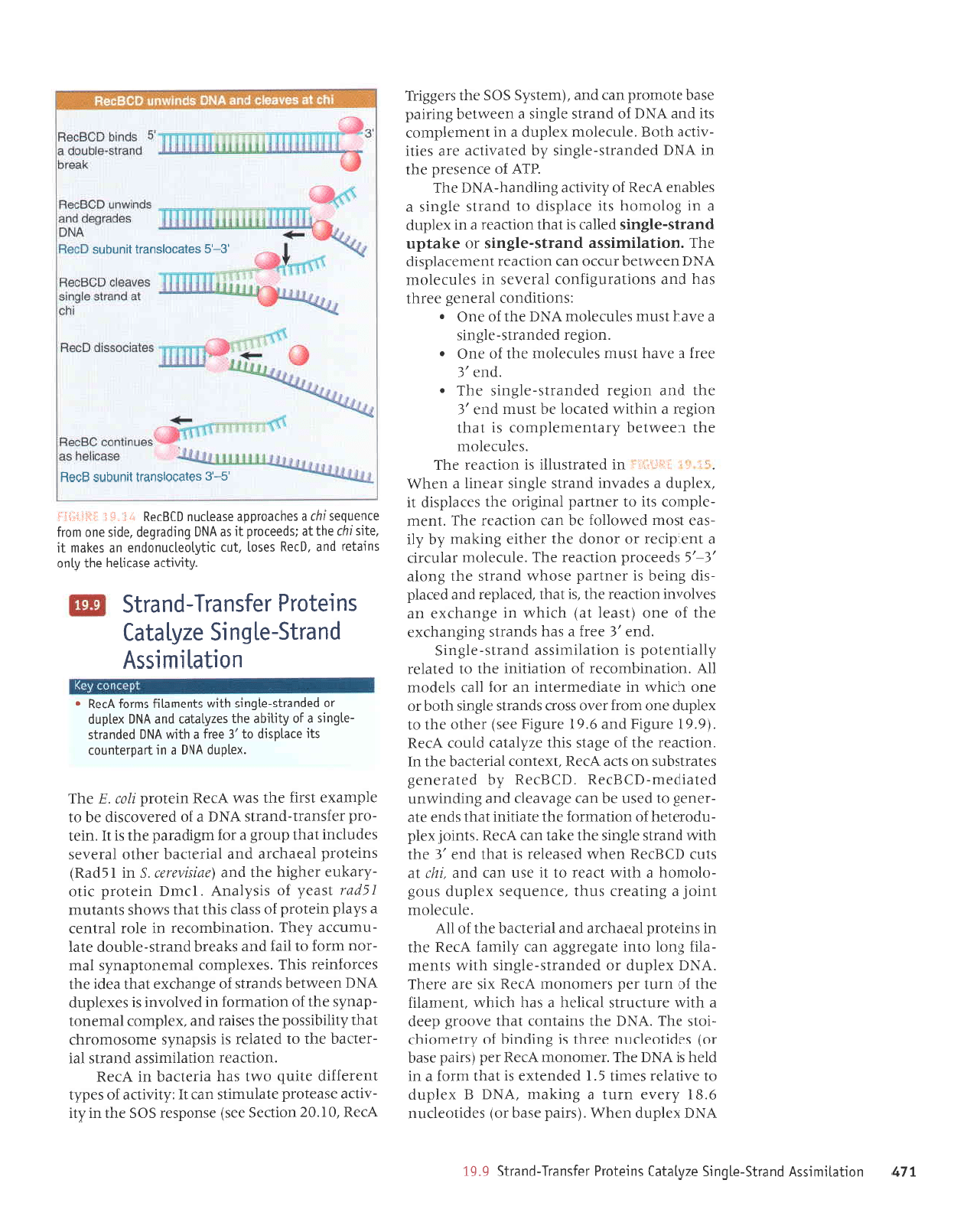
tLl
uorlel ru rssv
pu
Ptls-al Du rs ez^lelpl
su ralord ralsupll-pu
prls
6' 6
I
VNO
xeldnp
ueqM
'(srred
aseq ro) saprtoapnu
9'91
Lrazra urnt
e 3ur1eu
'VNC
S
xaldnp
o1
JAIIPIJJ setull
S'I
pepuJlxe
sr
leqt
ruroJ P ur
plJrl
sl
VN11
aqJ
'rJruouoru
Vrag
rad
(sled
aseq
ro)
saprtoalrnu aJrql sr Surpurq
;o
Lrlaruotqr
-rots
JqJ
'vt{O
Jqt sureluor
teqt
anoorS
daap
e
qlrM
JJnlJnJlS
IPrrlJrl
P SPr{ LIJTLIM
'luJtuellJ
Jql
Jo
urnl rad sraruouorx
VJaU
xrs
Jrp
aJJqJ
'ypq
xaldnp ro
prpuerls-a13urs qtl,t,t
sluau
-e1;
3uo1 otur a1e3ar33e uer
,,(1ue;
VrrU
Jtll
ur suratord
Ieaeqrre
pue
lprrJDeq
Jqt
Jo
IIV
'JInJJIOIII
lurof
e Surlean snql
'aJuJnbas
xaldnp
sno8
-oloruoL{
P
qlrM
IJPJJ
ol
lr
JSn uef
pue
't4)
le
slnJ (JgJeu uJqM
peseJlJr
sr
leql
pua
,€
Jql
qllnt pupJls
a13urs aql JIpl ueJ
yrag
's1utoI
xald
-nporJlaq
Jo
uorlPruro] Jqt JtPrlrur
]Pql
spue
elP
-raua8
ol
pJSn
aq ueJ a8e,teap
pue
3utput,,r,tun
pelerpau-()gJru'olgleu
f,q
paleraua8
sJlerlsqns uo
slle
vJJu
'lxJtuoJ
IPUJIJPq
Jql uI
'uouf,per
aqt
yo
a8els srql az.d1eler
plno)
VJaU
'(6'61
arn8rg
pup
9'6I
arn8r4 aas) raqlo
aqt ot
xaldnp
Juo ruoJJ rJAo ssoJJ spuerls a18urs
qtoq ro
auo
qJrqM
ur JlPrpaluJJlur ue roJ
IIPJ
slapolll
IIV
'uorleurqurorJr
Jo
uorlPrlrul Jql o1
pJlPIeJ
Lllertualod
sr uorlelrlursse
puerls-a13urg
'pua
,€
aJJJ
p
seq spueJls Sut8ueqrxa
aqt
Jo
auo
(1sea1
re)
q:rq,r,L
ur a8ueq:xa
ue
senlonur uortJeJJ Jql
'sr
tpqt
'pareldar
pue
pareld
-srp
Suraq sr rautred esoqM
puerts
aqt 3uo1e
,€-,s
spaJf,o.rd uorlreal eqJ
'JInJJIou
relnJJlf,
e
tuardoar
ro rouop Jqt JJqtrJ Surleut
.{.q
L1t
-sPe
lsour
pJMolloJ
aq uer uoIlJeJJ
eql
'luJlx
-alduor
sll cll
JJuued
leu6rro
aqt sareldsrp
t1
'xaldnp
E sepenur
pupJls
a13urs
reaurl
p
uJqM
',i
ri
,::riii:1.::
uI
palellsnlll
SI uOIpeJI
JqJ
'sJInf,elolu
Jqt ueamlaq Lreluaualdruor sr
teql
uor8ar e urqlrM
pJle)ol
Jq
lsnu
puJ
,€
Jqt
pup
uot8ar
papuerts-JISurs
aq1
.
'pua,€
JaIJ e e^Pq
lsnlu
SelnJJIou Jql
Jo
auo
.
'uorSar
papuerls
-
a13uts
e JAeq
lsnu
selnJJloul
YNO
Jql
Jo
auo
.
:suolupuoJ
lerauaS
aarql
sPq
puP
suorlernSrJuo)
IPTJAJS
ur sJlnJalou
YNC
uJeMlJq rnJJO ueJ uOIlf,eJJ
luaruareldsrp
rqI
'uoItpIFuIssE
puerls-a18u1s .ro a>1e1dn
puerls-a18uls palleJ
sI
lpql
uolDpar
e ur
xaldnp
e ur Soloutoq stl areldslp
ot
puerls a13urs
e
srlqeur
VlrU
Jo
Ltla,rDe Surlpueq-ypq
aq1
AIV
Jo
aruasard
aql
ul
yNCI
papuerls-a13urs .dq
patelltre
Jre
saltl
-AIpe
qlog
'alnJJloru
xaldnp
e ur
luarualdruor
slr
pup
vNO
Jo
pupJls
a13urs e
uJJMteq
Sutrred
eseq Jlouord
uer
pue
'(rua1s.{5
SOS
rql sra33tr1
VJeU
'0I'02
uoIpJS
aas)
asuodsa:
5gg
aqt ur .dlr
-ArlJe
esealord
alelnrutls
uBr
U
:,{.1t,l,rlle
1o
sad^d1
tuJJJJJrp
allnb
o,lrl spq
eIJJlJeq
uI
VJaU
'uorlJear
uorlelrursse
puerls
IeI
-JelJeq
Jql
o1
pelPIJJ sI SISdPU^S
JruOSOruOJtl)
leqt
rltryqrssod
aqf sesleJ
pue
'xaldruor
IeruJuol
-deu.ds
Jqt
Jo
uolteuJoJ
uI
pellolut
st saxaldnp
vN(
ueJMtaq
spuens;o
a8ueqrxa
leqt
eepl Jql
sJ)roJureJ
srql'saxalduroJ
lPurJuoldeuLs leru
-Jou
ruJoJ
o1
IrPJ
puP
s>leeJq
pueJls-elqnop
Jlel
-nurnJre
.daq1
'uotleulqruoJeJ
uI eloJ
IPJIUJJ
e s.{e1d uratord
Jo
ssplJ
slql
leql
sMoqs sluelnru
lEpat
6eeL;o
srsLleuy
'IJru(
uratord rrlo
-.dre1na
raq8tq
rq1
pue
(aatstnatac
S
q
I SpPU)
suralord
IeJpqJJp
pup
IeIJJI)pq
Jeqlo
IeJeAes
sapnpur
ter{t
dnor8
e ro; ur8rpered
aqr
sI
tI
'ulJl
-ord
ra;suerl-pueJls
VNO
p
Jo
paJJAo)sIp
aq ol
aldurexa
lsrrJ
eqt spM
Vrru
uletord
!p)'fl
eqJ,
'xaldnp
ypg
e ut
ledralunot
slt alPldstp
ol
/E
404
P
qllM
vN0
pepuells
-a16uLs
e
1o
r{1qLqe
aq1 sazfleler
pue
y16
xaldnp
ro
pepuetls-a16uts qltm
slueuel!J
sulroJ
VleU
.
uoqeltuLssv
puerls-al 6u
ls
az^letel
su
ralord JoJsuejf-puPJls
'A1LnL1re
oselrtaq
eq1 [1uo
surelal
pue
'Crau
sasol
'1nr
rtlAloelrnuopuo
uP salPttt
]t
'al!s
lq,
eql
le
jspaalold
1r
se
y16
6utpetbap
'opts
auo uol1
eruenbasrgr
e saqreoldde
osPollnu
0l8rau
iri'rrl
lijliirj:i
,g-,e
sslecolsuerl
Iunqns
gceH
,g-,9
salecolsuerl
ilungns
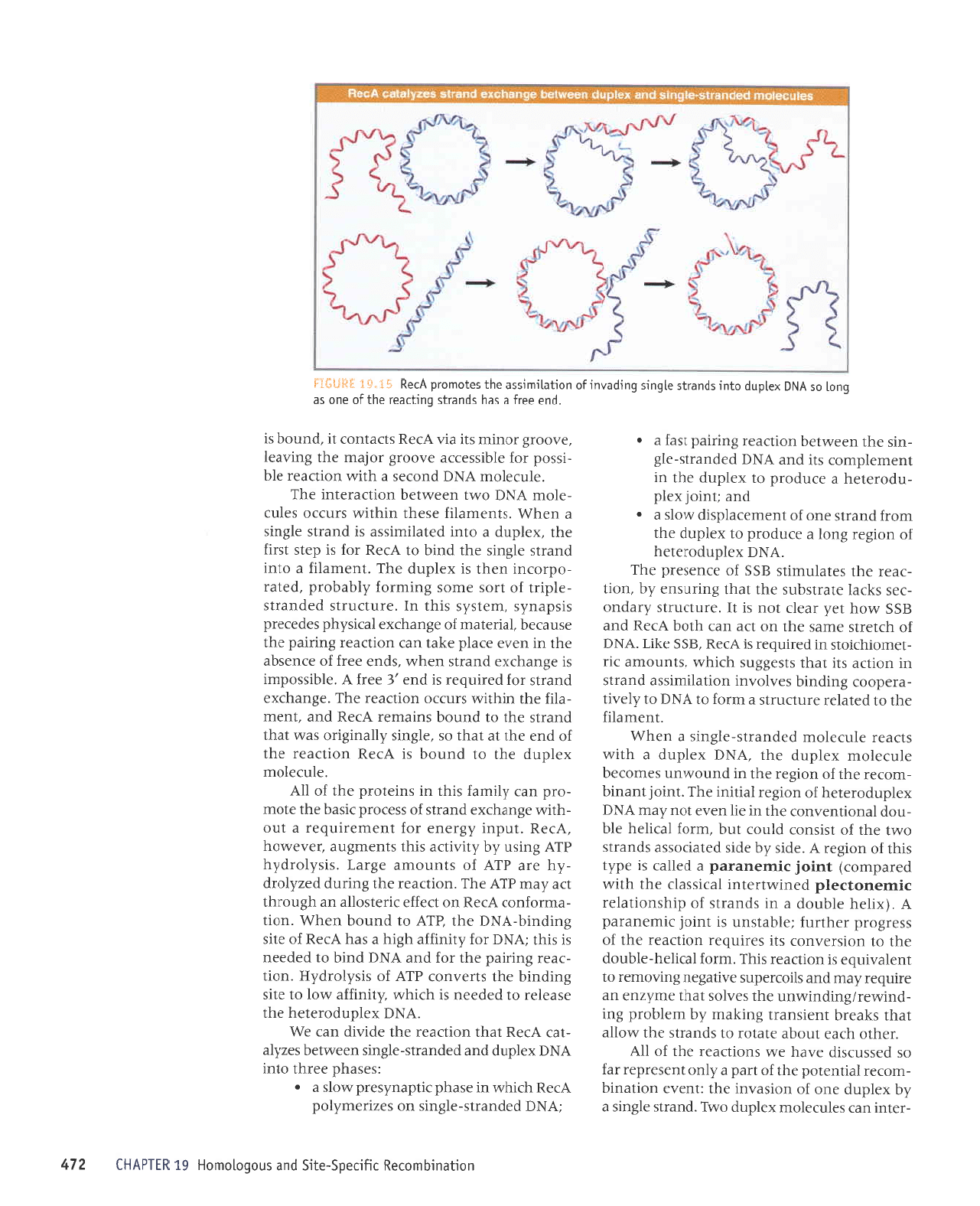
-Jelur
ueJ saln)Jloru
xaldnp
oMI'puerls
JISurs
e
,{q
xaldnp
Juo
Jo
uorspAur
Jql
:luJAJ
uorleurq
-uroleJ
Ieltuetod
aqt;o
Ued
e.{1uo
tuasardar
re;
os
pJssn)srp
JAeq
JAl
suortJeJr
Jqt
Jo IIV
'Jaqlo
q)eJ
lnoqp
Jlelol
ot spuerls
Jqt A\ollp
lpqt
s>leerq
tuJrsuprt
3ur>1eur Lq
rualqord
3ur
-pul,r,rarTSurpurMun
eql sJAIos
lpql
Jru^zua
ue
armbar,{eru
pue
slorradns
anrle8au
Surnoruar o1
luale,ttnba
sr uorlJeJr
srqJ
'uroJ
leJrlaq-alqnop
aql ol UoISJJAUoJ
sll
sJrlnbJt
uotlJpJ-r
Jql
Jo
ssarSord
rJqUnJ lJlqplsun
sr
turoI
lrruauered
V
'(xlleq
rlqnop
e
ur spuprts
Jo
drqsuortelar
)IruauolJeld
paurrrzrlralur
Ielrssel)
aql
qlrm
paredruor)
1u1oI
rpuauBrBd
e
palle)
sr ad.dl
slql
Jo
uor8ar
V
'Jpls
,{q
aprs
pJlprf,ossp
spupJts
o,&|l Jql
Io
lslsuor
plnoJ
lnq
',ruloJ
IeJrlJq
elq
-nop
IPuoIluJAuol
Jql uI
eIT uaAJ
tou
r(eur
ypq
xaldnporalaq
;o
uot8ar
Iprtlur
Jr{J'turoIlueurq
-ruo)al
aql;o uor8al
eql
ur
punoMun
saruoJeq
alnJeloru xaldnp
Jqt
'VN11
xaldnp
e
qtru
slJeJr JlnJJIotu pJpuerts-aJBurs
e
uJr.lM
'tuJluelrJ
Jqt ol
pJtplJJ
ernt)nJls
e
uJoJ ot
VNC
o1 L1anrl
-eradoor
Surpurq
sJAIoAur
uorlelrrursse pueJls
uI uollf,p sll
leql
slsaSSns
qJIqM
'slunorup
f,rr
-leuorqJrols
ur
parrnbar
sr
vJeU
'gSS
JII-I
'VNC
Jo
qllJlls
elues
aql uo
lJe
upl
qloq
vJJu
pue
gSS
Moq
1ad
reap
tou
sl
tI
'JJntJnlls
Lrepuo
-Jes
s>llpl
Jterlsqns
eqt
teql
Suunsua,{q
,uo1t
-)ear
Jql sJtplnrurts
gSS
Jo
aruasard
aq1
.y5g
xaldnpolJlJq
;o
uor8ar
3uo1 e
atnpord
o1 xaldnp
aqt
rloJJ
puprls
Juo
Jo
tuaruereldsrp
Mo[s
p
o
pue
lturol
xald
-npoJelJr{
e arnpord
o1 xaldnp
Jqt ur
luauraldruor
stl
pue
VNO
pJpuerls-a13
-uls
eql uaJuleq
uort)eJr
Surrred
lSpI
p
o
uor.]pulquolag
rgoad5-a115
pue
sno6olorxoH
6l
lVNC papuerls-a13urs
uo
sazrraru,,ilod
VIJU
r{Jrq,lr ur aseqd
rrldeu.dsard,rnols e .
:sJseq0
aJrql olul
ygq
xaldnp
pue
pepuerts-afurs
uaa,ulaq sazLp
-1e)
v)eu
]Pql
uorlJeeJ eql apr^p uel
JM
'YNO
xJIonporelJq
Jql
Jspeler ot
pJpJJu
sr
qlrqm
Ltrury;e .lrol
ol elrs
Surpurq rqt
suenuoJ
dJV;o
srsdlorp,{g
'uofl
-rear
3urrred Jqt JoJ
pue
VNq1
purq
ol
pJpJJu
sr srqt 1VNO
ro;,,(1rur;ye
qBIq
e spq
VreU
Jo
atls
Surpurq-ypq
rqt
AIV
ot
punoq
ueqM'uorl
-pruroJuoJ
VJJU
uo
peJJJ
)rJatsole
ue
qSnorql
tre,,leru
dIV
eqJ
'uortf,pJr
Jql Suunp
paz,{1orp
-Lq
are
dJv
Jo
stunourp aBrel
'srsr{1orp.{q
41y
Sursn dq,{.1r,rrpe
slql stuaur8ne
'Jene,troq
'V)JU
'lndur
,{8raua
JoJ
luJuaJrnbar
e
lno
-qtlM
eSueqJXJ
pueJls;o
ssarord rrseq aql
eloru
-ord
uer ,{lure;
srql ur suraloJd
eql
Jo IIV
'alnJaloIu
xaldnp
Jql
ol
punoq
sr
VJaU
uorlJeeJ Jql
Jo
puJ
Jql
}p teql
os
'a18urs
,,{lleur8rro
sem
teql
pueJls
aqt ot
punoq
surPruJJ
vJJu
pue
'lualu
-elIJ
aqt
ulqtru srnJJo
uorlJpJr aq1
'a8ueqrxa
pupJls
roy
parrnbar
sr
puJ
,€
JJJJ
V
'alqrssodrur
sr a8ueqrxa pupJls
uaqM
'spue
aJJJ
Jo
af,uesqp
aql uI
ueAJ areld alel
ueJ uorlJpJr Surrred
aql
asneJaq'leuJleru
;o
a8ueqrxa
1errs,{qd
saparard
srsdeuLs
'ruals,{s
srqt uI
'JrntJnJts
pJpueJts
-a1dul
Jo
uos
aruos
Surruroy .{lqeqord
'peteJ
-odrorur
ueql sr xaldnp
arIJ
'lueruplrJ
e olur
puPJls
a18urs aqt
pulq
ol
yJJu
roJ sr
dals
lsrr;
aqr
'xaldnp
p
olur
pelelrurrsse
sr
puerls
a13urs
e
ueqM
'sluetuellJ
esJql ulqlrM
sJnJJo selnf,
-elou
vNC
oMt ueaMteq
uorDeJslur
JqI
'JIn)elolu
vNC
puoJJs
e
qlrM
uorDeJJ JIq
-rssod
ro;
elqrssJJJe
a.r.oor8 roleru
Jr{l Surleel
'a,roor8
Jourur sll
ell
VJJU
slJeluoJ
ll
'punoq
sr
UlldVHl
ZLtr
'pua
eelJ
p
spq spuptls 6urlrear
aql
Jo
euo se
buol os
y116
xaldnp
olur spuetls
e16urs
6urpe,rur
1o
uotlplrulrsse
eq1 selouotd
VraU
{i"*i.
lsil*L*
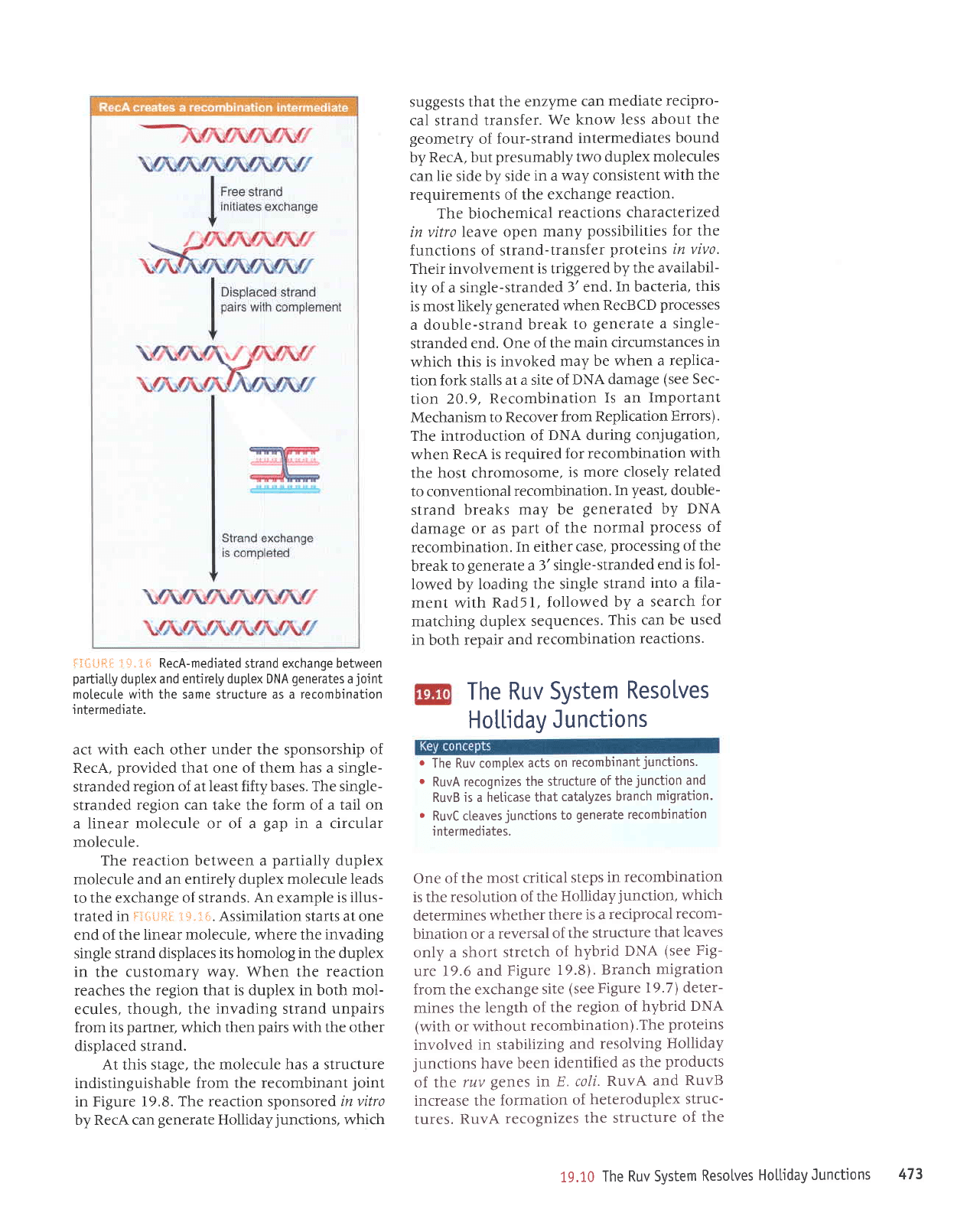
$:i:]Li+t
'.1
F.tti RecA-mediated
strand exchange
between
partiatty
duplex
and entire[y dupl.ex DNA
generates
ajoint
molecu[e with the same structure as a recombination
i ntermediate.
act with each other
under
the sponsorship
of
RecA,
provided
that one of them has a single-
stranded
region of at least fifty bases. The single-
stranded
region can
take the
form
of
a tail on
a linear molecule or of a
gap
in a circular
molecule.
The reaction between a
paftially
duplex
molecule and an entirely duplex
molecule leads
to
the exchange of strands. An example
is illus-
trated
in
Fi+{.FFtil .1+.it.
Assimilation starts at one
end of
the linear molecule, where the
invading
single strand displaces
its homolog in the duplex
in
the
customary way. When the
reaction
reaches the
region that is duplex in both mol-
ecules,
though, the
invading
strand
unpairs
from its
partner,
which then
pairs
with the
other
displaced strand.
At
this
stage, the molecule has a structure
indistinguishable
from the recombinant
joint
in Figure 19.8.
The reaction
sponsored
invitro
by RecA can
generate
Holliday
junctions,
which
suggests that the
enzyme
can
mediate recipro-
cal strand
transfer.
We
know
less
about the
geometry
of
four-strand
intermediates
bound
by
RecA, but
presumably
two
duplex
molecules
can lie side by
side
in a way consistent
with the
requirements of the
exchange
reaction.
The biochemical
reactions
characterized
in
vitro leave open
many
possibilities for the
functions of strand-transfer
proteins in vivo.
Their involvement
is triggered
by
the availabil-
ity of a single-stranded
3' end.
In bacteria,
this
is most likely
generated
when
RecBCD
processes
a double-strand
break
to
generate a single-
stranded end. One
of the
main circumstances
in
which this
is invoked
may
be when
a replica-
tion fork stalls
at a site
of DNA
damage
(see
Sec-
tion
20.9, Recombination
Is an Important
Mechanism
to Recover
from
Replication
Errors).
The introduction
of
DNA during
conjugation,
when
RecA is required
for recombination
with
the host chromosome,
is
more closely
related
to conventional
recombination.
In
yeast,
double-
strand
breaks
may be
generated
by
DNA
damage or as
part
of
the
normal
process of
recombination.
In
either
case,
processing of the
break
to
generate
a 3'single-stranded
end is
fol-
lowed
by
loading
the single
strand
into a fila-
ment with
Rad5l,
followed
by a search
for
matching duplex
sequences.
This
can be
used
in both
reuair and
recombination
reactions.
The Ruv
System
Resolves
Hol.l.iday
Junctions
o
The Ruv comptex
acts
on
recombinantjunctions.
.
RuvA recognizes
the structure
of the
junction
and
RuvB is a heticase
that
catalyzes
branch
migration.
r
RuvC c[eaves
junctions
to
generate recombination
intermediates.
One of
the most
critical
steps
in
recombination
is the resolution
of
the
Holliday
junction,
which
determines
whether
there
is a
reciprocal
recom-
bination or
a reversal
of
the structure
that Ieaves
only
a short
stretch
of
hybrid
DNA
(see
Fig-
ure 19.6
and Figure
19.8).
Branch
migration
from the exchange
site
(see
Figure
I9.7)
deter-
mines
the length
of
the region
of
hybrid
DNA
(with
or
without
recombination).The
proteins
involved
in stabilizing
and
resolving
Holliday
junctions
have been
identified
as
the
products
of the ruv
genes \n
E. coli.
RuvA
and
RuvB
increase the
formation
of heteroduplex
struc-
tures.
RuvA recognizes
the
structure
of the
19.10
The
Ruv System
Resolves
Hol.tiday
Junctions
473
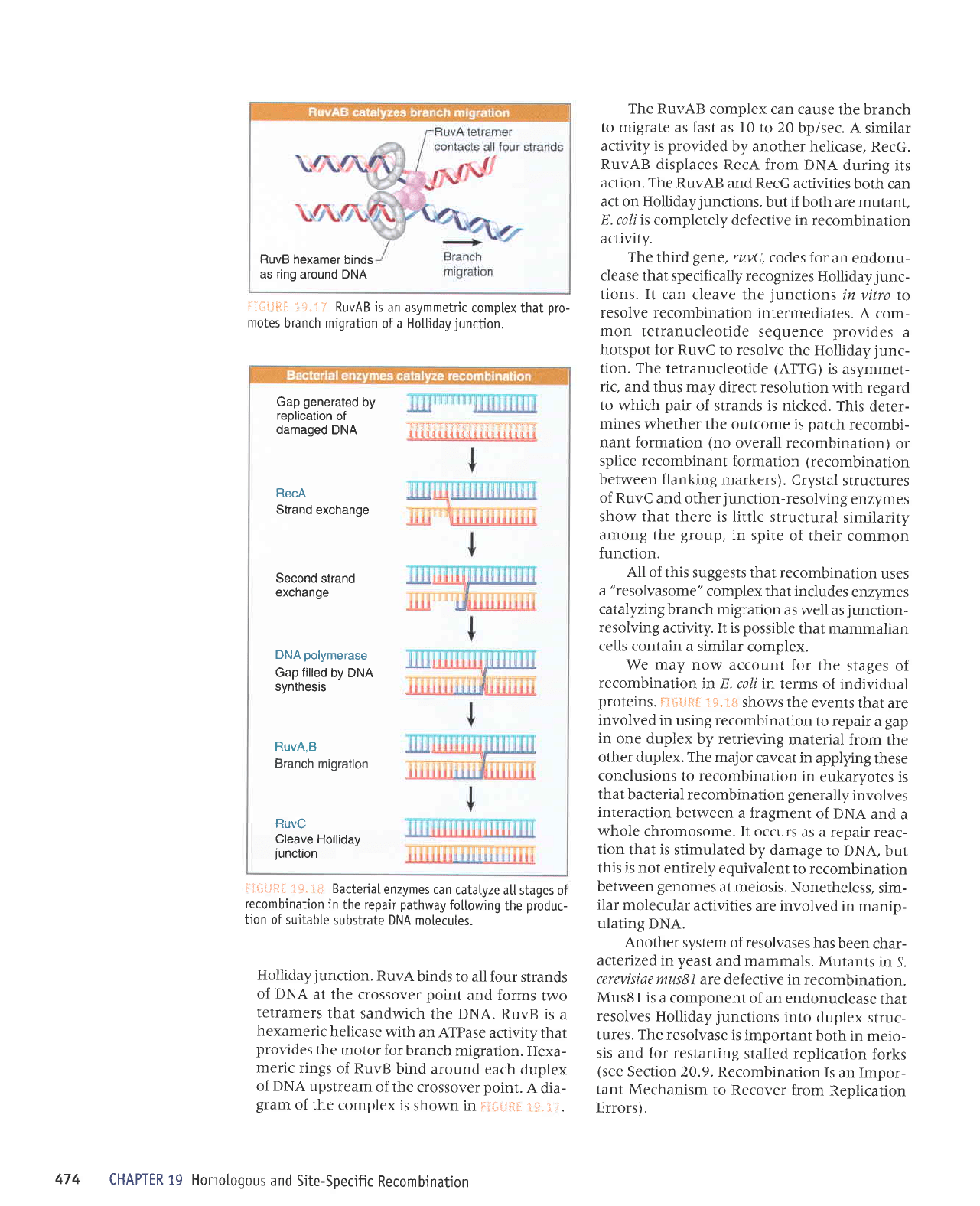
iirlijili l:i.iI
RuvAB is an
asymmetric
complex that
pro-
motes
branch migration
of a Hotlidayjunction.
i:
{:ii *
l i
*-"
i
S
BacteriaI
enzymes can
catatyze
a[[ stages of
recombination
in
the repair
pathway
fo[towing
the
produc-
tion of
suitabte
substrate DNA
molecutes.
Holliday
junction.
RuvA
binds to
all four strands
of DNA
at the
crossover
point
and forms
two
tetramers
that
sandwich
the DNA.
RuvB is
a
hexameric
helicase
with
an ATPase
activity
that
provides
the
motor for
branch
migration.
Hexa-
meric
rings
of RuvB
bind
around
each duplex
of DNA
upstream
of the
crossover
point.
A
dia-
gram
of
the complex
is
shown in
li{:i"rH*
'ti}":tt.
The RuvAB
complex can cause
the branch
to migrate
as fast as l0 to 20
bp/sec.
A similar
activity is
provided
by another helicase,
RecG.
RuvAB displaces
RecA from DNA
during
its
action. The
RuvAB and RecG
activities
both can
act on Holliday
junctions,
but if both
are mutant,
E. coliis completely
defective in
recombination
activity.
The
third
gene,
ruvC,
codes for
an endonu-
clease that specifically
recognizes
Holliday
junc-
tions. It
can cleave the
junctions
in
vitro Io
resolve recombination
intermediates.
A com-
mon
tetranucleotide
sequence
provides
a
hotspot for RuvC
to resolve
the Holliday
junc-
tion. The tetranucleotide
(ATTG)
is asymmet-
ric, and thus
may direct resolution
with regard
to
which
pair
of strands is
nicked.
This deter-
mines
whether
the outcome is
patch
recombi-
nant formation
(no
overall
recombination)
or
splice recombinant
formation
(recombination
between flanking
markers).
Crystal
structures
of RuvC
and other
junction-resolving
enzymes
show that there is
little structural
similarity
among the
group,
in spite
of their
common
function.
All
of this suggests that
recombination
uses
a
"resolvasome"
complex that includes
enzymes
catalyzing
branch migration
as well
as
junction-
resolving
activity. It is
possible
that
mammalian
cells contain
a similar
complex.
We may now
account for
the
stages of
recombination
in E. coli in
terms
of individual
proteins.
f+i;{JftE
i*.18 shows the
events
that are
involved
in
using recombination
to repair
a
gap
in
one duplex
by retrieving
material
from
the
other duplex.
The major
caveat in
applying
these
conclusions
to recombination
in
eukaryotes
is
that
bacterial recombination generally
involves
interaction
between
a fragment
of DNA
and
a
whole
chromosome.
It occurs
as a repair
reac-
tion
that is stimulated
by damage
to
DNA,
bur
this is not
entirely equivalent
to recombination
between
genomes
at meiosis.
Nonetheless,
sim-
ilar molecular
activities
are involved
in manip-
ulating
DNA.
Another
system of resolvases
has
been
char-
acterized
in
yeast
and mammals.
Mutants
in S.
cerevisiae mus81
are defective
in recombination.
Mus8l is
a component
of
an endonuclease
that
resolves
Holliday
junctions
into
duplex
struc-
tures. The
resolvase
is important
both in meio-
sis and for
restarting
stalled
replication
forks
(see
Section
20.9, Recombination
Is
an Impor-
tant Mechanism
to Recover
from
Renlication
Errors).
RuvB
hexamer
binds
as
ring
around
DNA
Gap
generated
by
replication
of
damaged
DNA
RecA
Strand
exchange
ilnilffililliffiii;'iil';
Second strand
exchange
DNA
polymerase
Gap
filled
by DNA
synthesis
RuvA,B
Branch
migration
RuvO
Cleave
Holliday
junction
474
CHAPTER
19 Homologous
and
Site-Specific
Recombination
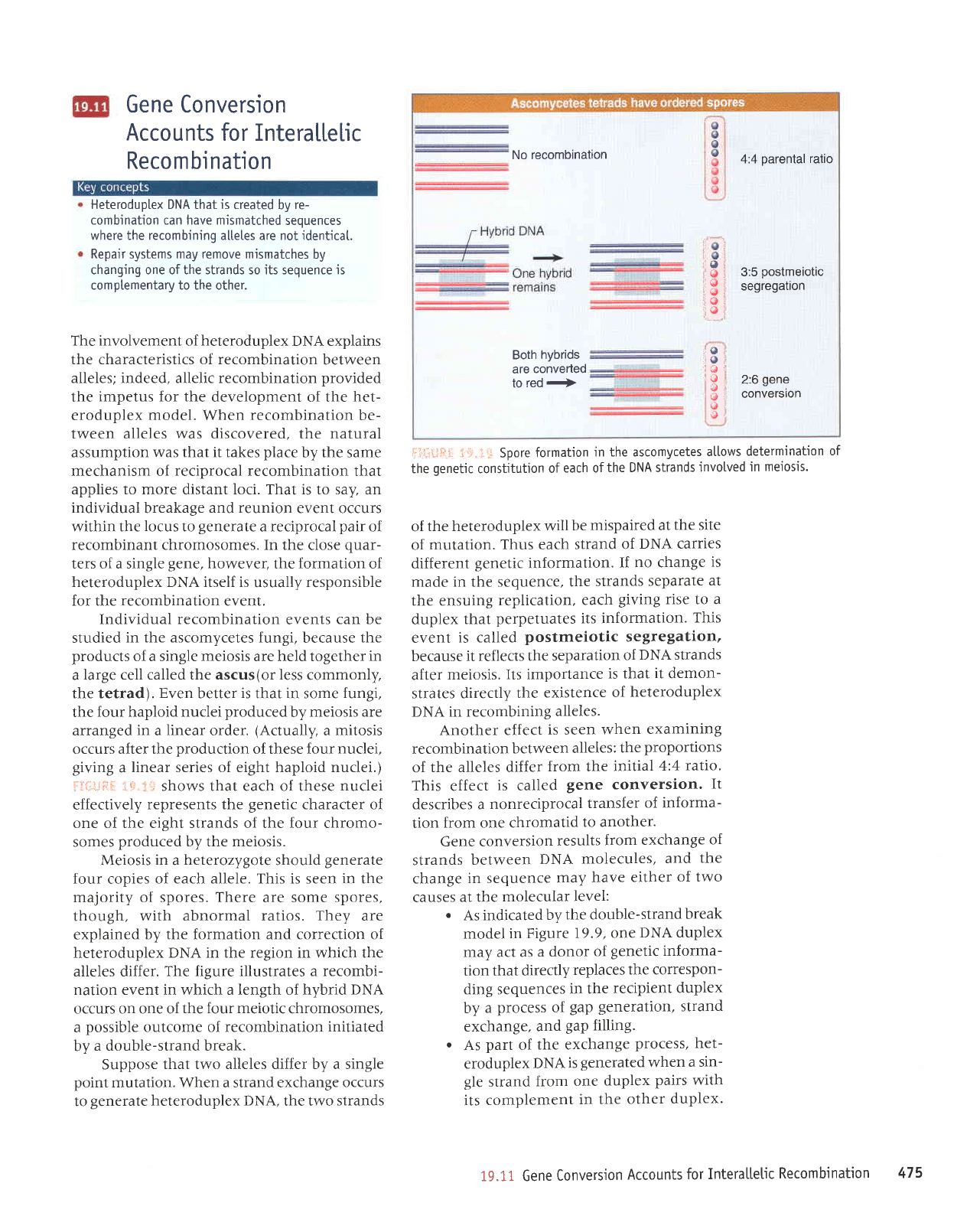
Gene Conversion
Accounts for Intera[[el.ic
Recombination
Heterodup[ex DNA that is created
by
re-
combination can have mismatched
seouences
where the recombining al[etes
are
not identicat.
Repair systems may remove mismatches
by
changing one of the strands so its sequence is
comptementary to the other.
The involvement
of
heteroduplex
DNA explains
the characteristics of recombination
between
alleles; indeed, allelic recombination
provided
the
impetus for the
development of the
het-
eroduplex
model.
When recombination be-
tween alleles was discovered, the natural
assumption
was
that it takes
place
by the same
mechanism of
reciprocal
recombination that
applies to more distant loci. That is to say, an
individual
breakage
and reunion
event occurs
within the
locus
to
generate
a reciprocal
pair
of
recombinant chromosomes. In the
close
quar-
ters of a single
gene.
however,
the formation of
heteroduplex DNA itself is
usually
responsible
for the recombination event.
Individual recombination
events
can be
studied
in the ascomycetes fungi,
because
the
products
of a single meiosis are held together in
a
large cell called the ascus(or Iess
commonly.
the tetrad).
Even
better
is
that in some
fungi,
the
four haploid nuclei
produced
by
meiosis are
arranged in a
linear
order.
(Actually,
a
mitosis
occurs after the
production
of these four
nuclei,
giving
a
linear series of eight haploid nuclei.)
i:iiiiifii
.i
-:. i,-i
shows that each of these
nuclei
effectively
represents the
genetic
character of
one of the eight strands of the four chromo-
somes
produced
by the meiosis.
Meiosis
in
a
heterozygote
should
generate
four
copies
of each allele. This is seen in the
majority of spores.
There
are some
spores,
though,
with abnormal ratios. They are
explained
by the formation and correction of
heteroduplex
DNA in the region in which the
alleles differ.
The figure illustrates a recombi-
nation event in which a length of hybrid
DNA
occurs on one of
the four meiotic
chromosomes,
a
possible
outcome of recombination initiated
by
a double-strand break.
Suppose
that two alleles differ by a single
point
mutation. When a strand exchange
occurs
to
generate
heteroduplex
DNA,
the two
strands
No recombination
4:4
parental
ratio
i'I
ii
rC:
ro:
:@;
1@i
1@i
:@i
3:5
postmeiotic
segregation
Both
hybrids
r@i
ioi
'9
'
2:6gene
S
r
conversion
iJi
are
conveded
to red
*
fii;;l,i.it5
:ii;,:lr
Spore
formation
in the ascomycetes
atlows
determination
of
the
genetic
constitution
of
each of
the DNA strands
jnvolved
in
meiosis.
of
the heteroduplex
will
be mispaired
at
the site
of
mutation. Thus
each strand
of
DNA carries
different
genetic
information.
If no change
is
made in the sequence,
the
strands
separate
at
the ensuing
replication,
each
giving rise to a
duplex
that
perpetuates its information.
This
event
is called
postmeiotic segregation,
because it reflects
the separation
of
DNA strands
after
meiosis.
Its importance
is that
it
demon-
strates directly
the
existence
of
heteroduplex
DNA in recombining
alleles.
Another effect
is seen
when
examining
recombination
between
alleles:
the
proportions
of
the alleles differ
from the
initial
4:4
ratio.
This effect
is called
gene conversion.
It
describes a
nonreciprocal
transfer
of informa-
tion
from one chromatid
to another.
Gene conversion
results
from
exchange
of
strands
between
DNA
molecules,
and
the
change
in sequence
may
have
either
of two
causes
at the
molecular
level:
.
As indicated
by
the double-strand
break
model
in Figure
I9.9, one
DNA duPlex
may act as
a donor
of
genetic informa-
tion
that directly
replaces
the correspon-
ding sequences
in the
recipient
duplex
by
a
process of
gap
generation, strand
exchange,
and
gap
filling.
.
As
part
of
the exchange
process, het-
eroduplex
DNA
is
generated when
a sin-
gle
strand
from
one
duplex
pairs
with
its
complement
in the
other
duplex.
19.11 Gene
Conversion
Accounts
for Interattetic
Recombination
475
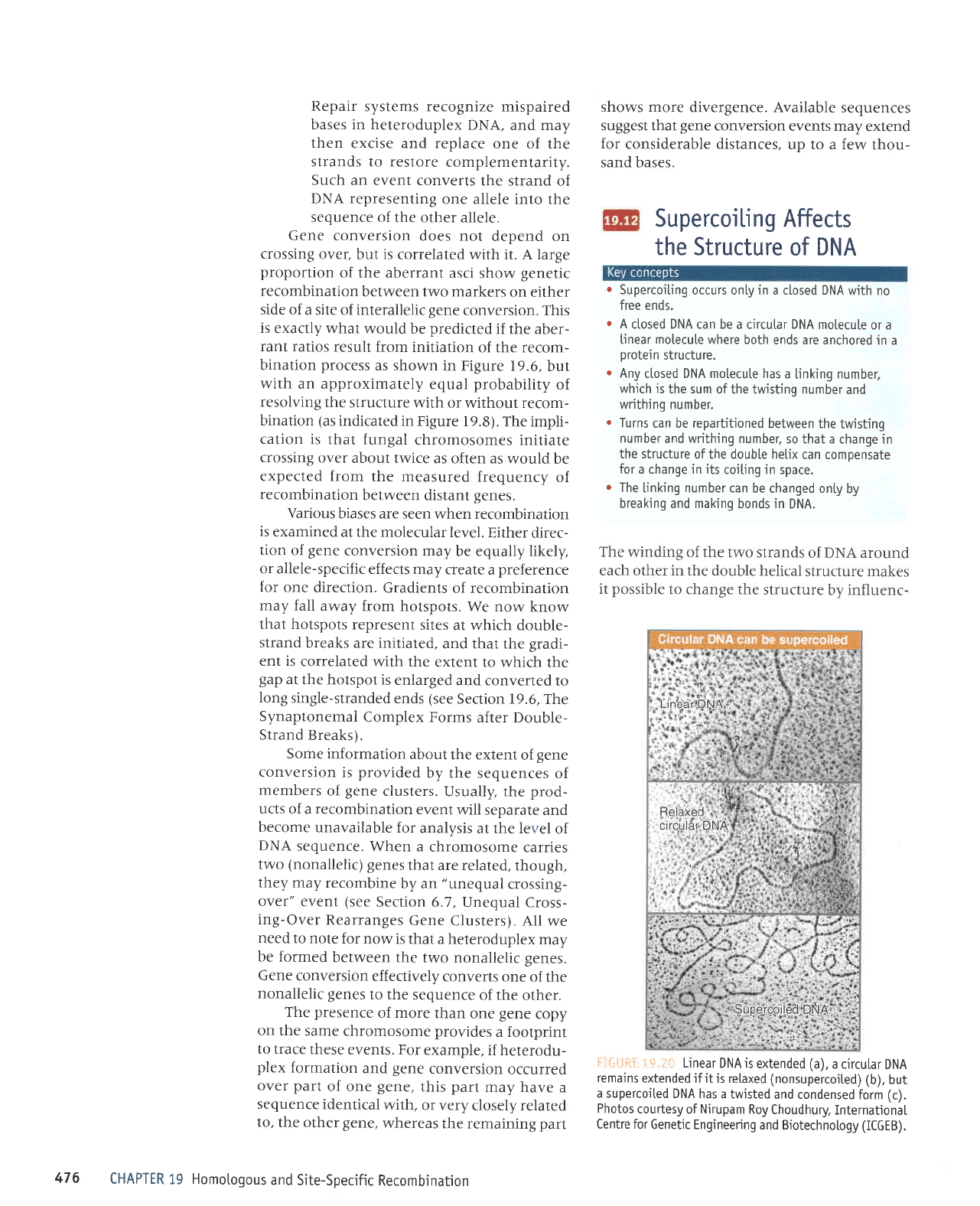
Repair
systems recognize
mispaired
bases in heteroduplex
DNA,
and may
then
excise and replace
one of the
strands to restore
complementarity.
Such
an event converts
the strand of
DNA
representing
one allele into
the
sequence
of the other allele.
Gene conversion
does not
depend on
crossing
over,
but
is
correlated
with it. A large
proportion
of the aberrant
asci
show
genetic
recombination
between two markers
on either
side
of a site of interallelic
gene
conversion. This
is
exactly what
would be
predicted
if the aber-
rant
ratios result
from initiation
of the recom-
bination
process
as shown
in Figure 19.6,
but
with
an approximately
equal
probability
of
resolving
the
structure with
or without recom-
bination
(as
indicated in
Figure I9.8).
The impli-
cation
is that fungal
chromosomes
initiate
crossing
over
about twice
as often as
would be
expected {rom
the measured
frequency
of
recombination
between distant
genes.
Various
biases are seen
when recombination
is
examined
at the molecular
level.
Either
direc-
tion
of
gene
conversion may
be equally likely,
or allele-specific
effects may
create
a
preference
for one
direction.
Gradients
of recombination
may
fall away
from hotspots.
We now
know
that hotspots
represent
sites
at which double-
strand
breaks are initiated,
and that the
gradi-
ent is
correlated
with the
extent to which
the
gap
at
the hotspot is
enlarged
and converted
to
long
single-stranded
ends
(see
Section
19.6, The
Synaptonemal
Complex Forms
after Double-
Strand
Breaks).
Some information
about
the extent
of
gene
conversion
is
provided
by the sequences
of
members
of
gene
clusters.
Usually, the
prod-
ucts
of a
recombination
event
will
separate and
become
unavailable
for
analysis
at the level
of
DNA
sequence.
When a
chromosome
carries
two
(nonallelic)
genes
that are related,
though,
they may
recombine
by
an
"unequal
crossing-
over"
event
(see
Section
6.7,
Unequal Cross-
ing-Over
Rearranges
Gene
Clusters). All
we
need to note
for now
is that
a heteroduplex
may
be formed
between
the two
nonallelic
genes.
Gene
conversion
effectively
converts
one
of the
nonallelic
genes
to the
sequence
of the
other.
The
presence
of more
than
one
gene
copy
:"^rl:
r-1-.
chromosome provides
a footprint
to trace
these
events. For
example,
if heterodu-
plex
formation
and
gene
conversion
occurred
:;:,x":#;s:r'ffi.:;":li:',:H*#liT
CHAPTER
19
Homotogous
and Site-Specific
Recombination
shows more
divergence. Available
sequences
suggest that
gene
conversion
events may
extend
for
considerable distances,
up to a few
thou-
sand bases.
SupercoiLing Aftects
the Structure
of DNA
.
Supercoiting
occurs on[y in a closed DNA
with no
free ends.
r
A
ctosed DNA can be
a circutar DNA motecule
or a
[inear
molecute
where both
ends are anchored
in a
protein
structure.
o
Any ctosed DNA molecute has
a [inking number,
which
js
the sum
of the twisting number
and
writhing number.
r
Turns
can be repartitioned
between the
twisting
number
and writhing number,
so that a
change in
the structure
of the double helix
can comoensate
for a change in its
coiting in space.
o
The
linking number can
be changed onl.y
by
breaking and making
bonds
in
DNA.
The
winding of the
two strands
of DNA around
each other in the
double helical
structure makes
it
possible
to change the
structure
by influenc-
M:i"9ftt
t
S.Iii
Linear
DNA is
extended
(a),
a circular
DNA
remains
extended
jfit
is retaxed (nonsupercoiled)
(b),
but
a supercoiled
DNA has
a twisted
and condensed
form
(c;.
Photos
courtesy
of
Nirupam
Roy
Choudhury.
InternatjonaL
Centre for
Genetic Engineering
and Biotechnology
(ICGEB).
476
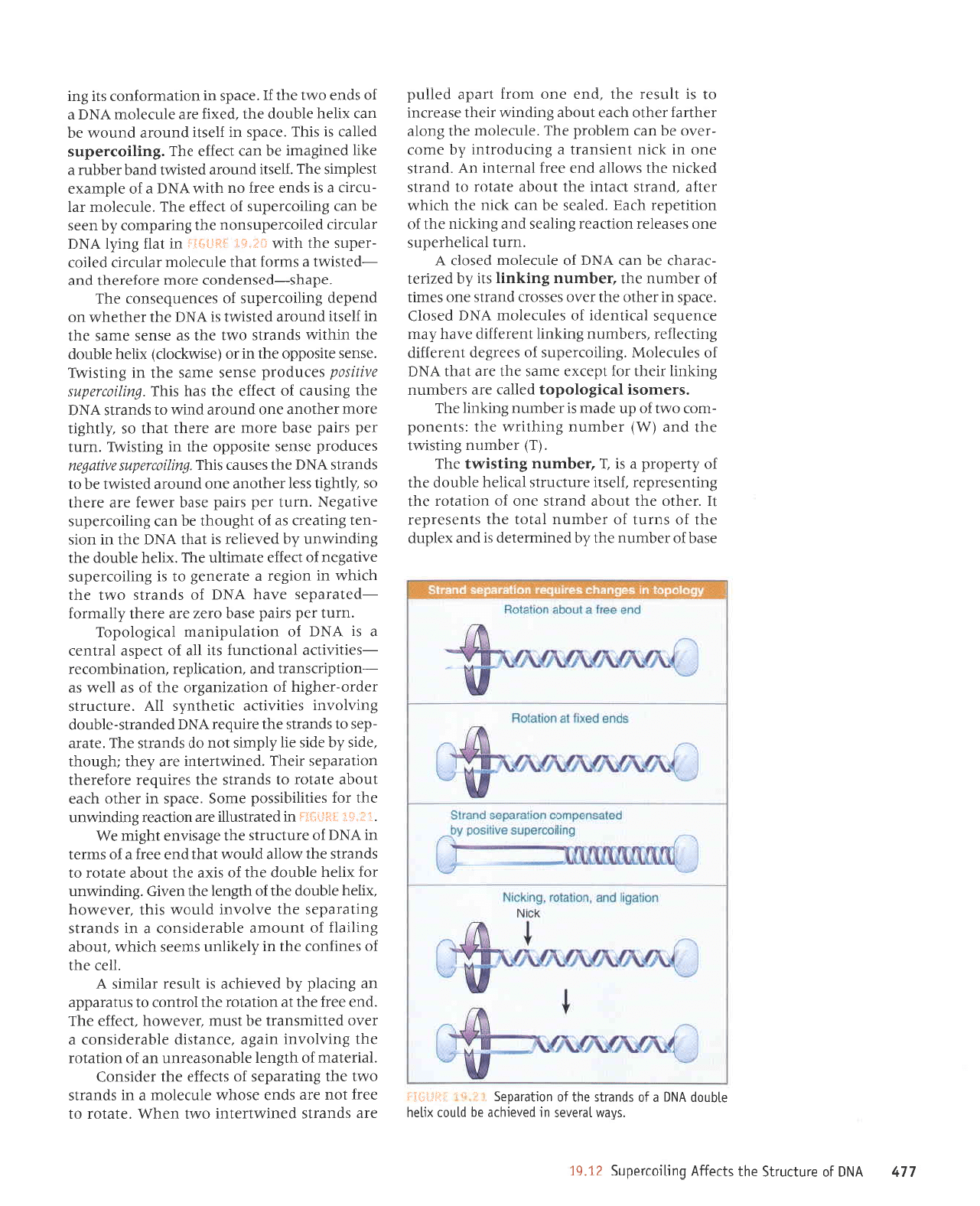
LL'
VN6
to
arnpnrts
aq]
spa#V 6ur1ro:radn5
71'61
's^PM
lPro^es
ur
pa^arqlp
aq
plnor
xrloq
elqnop
vN0
P
Jo
spuplls eq1
1o
uoLletedas
,:
,:
I :iijiilli.jt
aseq
Jo
JJqrunu
aql ^q
pJurruJetJp
sr
pue
xaldnp
aql
Jo
surnl
Jo
JJqrunu
lptot
Jql sluasardar
1I
'Jeqlo
Jql
lnoqP
pueJls
euo
Jo
uorleloJ
eql
Surtuasardal
'JIJstr
JJntJnJts
IeJIIaq
JIqnop
eql
;o.dgadord
e
sr
I'requrnu
3ur1srm1 aq1
'
(g)
raqurnu Surtstzrtl
Jqt
pup (14)
raqrunu Surqtrr,n aqt
:stuauod
-ruoJ
o.l,tt
Jo
dn
aperu sr Jaqurnu 3uqur1
aql
'sreurosl
pr;Eo1odo1 pJIIpr
ere srequnu
3uqu11
rrJqt JoJ
tdarxa
eues eql ere
tpqt
vNC
Jo
selnrelow
'Surlorradns
yo
saar8ap
IUJJJJJIp
Surpauar'sJJqunu
8ur>1uq
tuaJeJJrp
a,req.deru
aruanbas
leJrluepr
Jo
sJlnlelou
VNC
pJSol)
'areds
ur raqlo Jql rJAo
sJSSor)
puerls
Juo sJurll
Io
JJqunu Jqt'raqulnu
3up1u11
slr
Lq
pazrral
-JereqJ
Jq uer
vN(
Jo
elnJsloru
pJSolJ
v
-
'urnr
IeJIIsqrJons
auo sJSeJIJJ uorl)eal
3u11eas
pue
Surpru
aql;o
uorlrladar
qJpg
'peleas
aq ueJ
>lJru
Jqt
qJIqM
JJ1JP
'pueJls
pPlur
Jql
lnoqp
elelor
()1
puerls
pJ>lJru
Jql sMollP
pue
eeJJ
leuJalur
uv
'puerls
Juo ur >l)ru
luJrsuprl
e Sunnporlur dq aruor
-relo
eq uer rualqord Jr{J
'aln)elou
aqt
3uo1e
raqueJ
Jeqlo
q)Ea
lnoqe
SurpurM rraql
JSeJJJUI
ol sr
llnsJr
aql
'pua
Juo ruoJJ
rrede
pa11nd
ale
spueJls
peurMuJlur
oMl ueqM
'alPloJ
ol
eeJJ
lou
eJe spua esol{^\
JlnJelou P uI spuPJls
oml eql Surteredas
Jo
spJJJJ
Jqt JJpIsuo)
'lerrJlpru
Jo
er8ual
JlqeuospeJun up
Jo
uollplor
aql 3ur,r1o,rur
ure8e
'aruelslp
JlqpJeplsuot
p
re^o
pJllrusuerl
aq
lsnru
'Je^elv\oq 'peJJe
eqJ,
'pue
eaJJ aqt
te
uoneloJ Jqt
lor1uot
o1 snteredde
ue 8une1d
dq
panarqre
sr
llnsJJ
JplItuIS
v
.llar
eql
Jo
seurJuoJ aqr
ur r{1a4tun sruaes
qJIqM'lnoqe
3urge1;
Jo
tunorue
alqpJJprsuoJ
e uI spuerls
Surleredas
erlt eAIoAuI
plnom
slql
'Jene,lroq
'xrtrq
Jlqnop aqr
yo qr8ual
eqt uallg
'Surpur,vrun
roJ xrlJq alqnop Jql
Jo
srxP aq1
lnoqP
elPloJ ol
spueJls Jqt
Molle
plnoM
lPql
puJ
aar] E
Jo
slurel
ul
VNo
Jo
JJntJnrts
aql a8esu.ua
rq8tut
a14
'
j.
i'i'
rrr
i.
:l
li
il l".1ilj
ln
peleJlsnru
are
uotDea: SuIpuIMun
Jqt roJ
sarlqrqrssod aruog
'areds
uI
rJqto
qJeJ
tnoqp
JleloJ ol spueJls
aqt sartnbar
JJoJeJeql
uorteredas
Jrer{J
'peurmuJlur
eJe
[aqr lq8noqr
'aprs
,{q
Jprs
JrT z(ldrurs
tou
op spupJts eqJ
'a}ere
-das
o1 spuerls aqt
arnbar
yN(
pJpuprls-Jlqnop
3ut,r1o,Lut
seIlIAIlJe
rllaqlur(s
ilV'JrnllnJls
rapro-raq8rq
Jo
uorlezlup8ro
aql
Jo
se
lla,lt.
se
-uorldrDsuPrl
pue'uorlerrldar'uolleulqluoJeJ
-saltlnlDe
Ieuoltlunl
s1I
IIe Jo
tr:dse
IPJluel
e sl
VN(
yo
uorlelndrueru
1err3o1odo1
'urnl
rad srred aseq
otez ete
araql ,{leruro;
-paleredas
r^er{
VN(
Jo
spuetls o,r,tl JI{l
q)lqm ur uor8at
e aleraua8 ol
sr Sutltotradns
anue8au
Io
trrJJe
alprultln
JqJ
'xlleq
rlqnop aql
Surpur.l,tun
Lq
pa.a,arlar
sr
tpql
VN(
eql uI
uoIS
-uat
3urlea.rr se
yo
lq8noqt
Jq ueJ Surlorradns
anr1e8a51
'urnl
rad srted
aseq JaMeJ
JJP eJeql
os
.{1tq31r ssal
JJqloue Juo
punoJe
pelslmt
aq ol
spueJts
VNO
eql sesneJ
stqT'6u17touadns
anqadau
sarnpord
asuas
alrsoddo
aqr ut SutlstaAl
'urnl
rad
srred JSeq JJoru
aJe Jreqt
teql
os
.d11q31t
erou
Jaqloue auo
punoJe
puIM
01 spueJls
vN(I
aqt
Sursner
Io
DJJJa
eqt
seq stq1'Qutltouadns
aruilsod sarnpord
JSUJS
eurps aql
uI 3ut1st,,t41
'asuas
alrsoddo aqt
ur ro
(aslrzqrop) x[eq
alqnop
Jql UqlrM
SpueJls o^tl
Jq1 se
esuJs Jrues aql
ur
Jleslr
punoJP
palslMl
sI
YN(I
Jql
JJqleqM
uo
puadap
Surgorradns
;o
saruanbasuo)
aqJ
'adeqs-pasuJpuoJ
eJolu
eJoJJJJql
pup
-pJlsIMl
e suroJ
lPql
elnJalolu
JPInf,JIJ
pJIIol
-radns
eqt
qtIM
{iii"#t :i!}{l*J.i
ul
leg
3ut,{1yl{q
Jelnf,JrJ
palorradnsuou
eqt
Sutredtuor
Lq uaas
Jq ue)
Suqrorradns
Jo
IJJJJa
eqJ'alnJelou
rcl
-nJJrJ
e sr
spuJ eeJJ ou
qll,vr
VN61
e
1o
aldruexa
lsaldrurs
JqJ
'Jlestl
punoJe
prtslMl
pueq
raqqnr e
a1l
paur8erur
aq ueJ
DeJIe
eqJ
'Eulgorradns
pJIIeJ
sr
srql
'areds
uI
JIJSII
punoJp
punom
Jq
ueJ
xrlrq Jlqnop
rql
'paxlJ
are JlnJelou
VNCI
e
Jo
spuJ
omt aql
JI
'areds
ur uolleurJoluor
slr 8ur
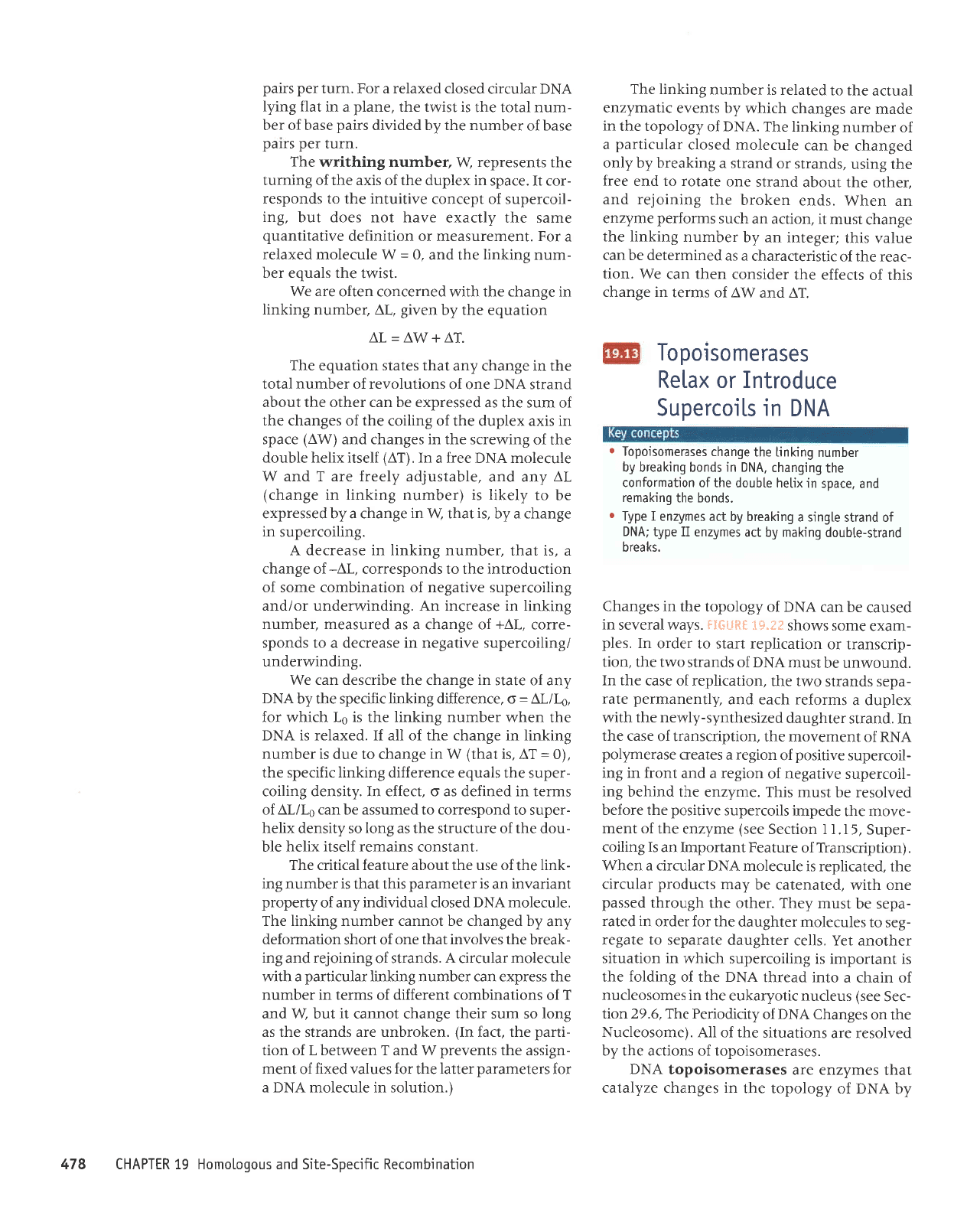
dq
VXq
;o
dSolodor
eql ur saSueqr
az[1e1et
leql
saru^,(zuJ
eJe
sespraruosrodol
ygq
'seserJurosrodol
Jo
suonre
aqr
,{q
pJ^loseJ
eJe suortentrs
Jql
Jo 11y'(auosoapnSl
aql uo sa8ueq3
VNq1
Io
^dlorpoga4
JqI'9'62 uorl
-rag
aas) snaltnu
rrlodre>lne
aql ul seurosoJl)nu
Jo
ureq)
e olur
peJJql
VNCI
rql
Jo
3urp1o1 aqt
s1
luelrodrur
sr
Surlrorradns
qlrqm
ur uorlenlrs
Jaqloue
tJ,1
'sllJJ
ralq8nep
aleredas ol
ate8ar
-3as
ol selnteloru
Jatq8nep
eql JoJ lJpro
ur
peleJ
-edas
aq
lsnru
,{aq1
'leqto
Jql
q8norqr passed
Juo
qtr.&{
'peleueteJ
aq
,{eru
spnpo-rd
JelnlJrJ
aqt
'palerrldJJ
sr elnJalou
VNC
JelnlrJ
p
ueq6
'(uoqdrnsue.Il
Jo
JrnteeC
luelrodurl
ue s1 Supor
-radng
'S
I'I I
uorDeg
aas) aru,{.zua
eql
Jo
tueu
-alour
aqt apadul
slorradns
a,rrlrsod eql
aroJJq
pJAIoSJJ
Jq
tsnru
srql
'au.dzua
aql
purqaq
8ur
-porradns
anrle3au yo
uofar
e
pue
luor;
ur
3ur
-lorradns
a,rrlrsod;o
uor8ar
e salearl
aseraru,{.1od
vNU
Jo
tueurelour
aq1
'uortdursupJl
Jo
JSp)
Jql
uI'pupJls
.ralq8nep
pazsaqlur{s-zi.lrrzlau
Jqt
qtl.tl
xaldnp
p
suroJal qlpe pue
[lluauerurad
ater
-edas
spuerls
oMt aqt
'uor1err1da.r
Jo
JSeJ eqt uI
'punoMun
aq
lsnlu
yNo
Jo
spueJls o1!\l
Jql
'uop
-drnsuert
ro uorterrldar
uels
01 JepJo u1
'sa1d
-Iuexa
Jruos sMoqs
A*'+I
ti*l!*i*
'sLea,r
lera,Las
ur
pasnpJ
rq
upt
VNO
Io
dSolodol
aqt ur sa8ueq3
'slealq
puprls-alqnop
6uo1eu
r{q
1re
saur\zua
11
adAl :y1r16
Jo
puerls
a16urs
e burleerq r\q
pe
saur\zua
1
adr\1
r
'spuoq
aql
Dur)euol
pue
'ereds
ut xrloq
olqnop
or{l
Jo
uorlpulloJuol
eq1 6uLbueqr
'VNg
ul spuoq 6uLlearq [q
taqunu 6uquq
aq1 abueqr
sasetauosrodol
o
vNo
ur slrolradns
alnpojlul
ro xPlau
sasPleuosrodol
'IV
pue
MV
Jo
surral ur a8ueqr
slqr
Jo
S1JJJJJ
eql JJprsuoJ
uer{l
uef, JAA
'uorl
-)EAJ
Eql
JO
]IISIJJDEJEqJ
E
SP
PAUIUIIJ1JP
Jq UEJ
Jnlpl
srql
lra8atur
ue ,{q
raqrunu
3ur4ur1 aqt
a8ueqr
tsnu
lI
'uorDe
ue
qJns
sruro;rad
Jur^zuJ
ue
uaq6
'spue
uJ>loJq
ar{t
Sururofar
pue
Taqlo
eqt
tnoqe
pueJls
euo
Jlptor ot
puJ
JJrJ
aqt Sursn
'spuerls
Jo
pueJls
e 3ur>1ea,rq
,{q,{.1uo
paSueqr
Jq up)
JInJJloru pJSolJ
relnrrlred e
Jo
requnu
8ur4uq
rqJ
'VN(;o
d3o1odo1
aqt ur
Jperu JJe sa8ueqr q)lqM
Lq
stua.La rrteurr(zua
I€nDB
eql 0l
pelelJr
sr Jaqrunu
Suopq aq1
('uor1n1os
ur elnJJloru
VN(
e
JoJ sJelarueJed ra11e1 Jq1 JoJ senlpn
pexrJ
Jo
luJru
-u8rsse
aql sluarrard
14
pue
I
ueaMlJq
f
Jo
uop
-rged
aqt
'ney
u1)
'ua>loJqun
are spupJts eql se
3uo1
os tuns Jreql a8ueqr
louueJ
11 lnq
'M
pue
J
JO
SuorlPurqruoJ
luJJJJJrp
Jo
sruJel ur JJqrunu
Jqt ssardxe
ueJ Jeqrunu 3ur1u{ relnrprcd e
qll,rt
JlnJeloru JelnJJrJ
V
'spupJls
Jo
Sururolar
pue
8ur
->leeJq
Jql ss^Io^ur
]Pql
euo
Jo
uoqs
uoueuuoJJp
z(ue u(q
pa8ueqr
Jq
touuef,
requrnu
Suquu aq1
'alnJaloru
vN(
pJsolJ pnpr,rrpur
[ue;o zfurado.rd
luerrplur
ue sr JJlerupJed sql
leql
sr Jeqrunu 8ur
->luIT
eql
Jo
JSn Jql
lnoqP
ernleJJ
leJrlrrJ
JqJ
'luelsuoJ
surP[reJ
JIeslr
xleq elq
-nop
eqt
Jo
eJnlJnJls aql se Suol os ,{lrsuap xqaq
-redns
o1
puodsarroJ
ol
parunssp
aq ueJ
o'i/'IV
Jo
srurrl
ur
pJurJJp
se
o
'DeJIe
uI
'^llsuep
Surpor
-JJdns
aq1 slenba aJUJJJJJTp Suquu
rrJoads aqt
'(o
=
tV
'sI
teqt)
14
ut a8ueqr 01 Jnp sI requnu
3ur>1uq ur aSueqr eril
Io IIe JI
'prxelrr
sl
VN11
eqt uJqM reqrunu 3ur1ur1 eql
sl
0f
qJrqM
JoJ
'o-U15
-
o
'rruereJlp
Suqull tgoads aqr z(q
y1qq
Lue;o
elpls ur a8ueqr Jqt JqrrJsap ueJ
JM
'Surpuunrapun
TSulporradns
arrrte8au
ur JspJJJap e ot spuods
-JrJo)
'fV+
Jo
a8ueqr e se
pernseeru
JJqunu
Suqurt ur JspeJJur uy
'Surpurrr,tJapun
ro/pue
3ur[orradns a,lrle8au
Jo
uorleurquro)
eruos
Jo
uorlJnpoJlur
eql 01 spuodsJJJoJ
'fv-
Jo
aSueqr
e
'sI
lpql
'Jaqrunu
3ur>1ur1 ur aseaJJep
V
'Surgor:adns
ur
a8ueqr e dq
'sr
1pql
'M
ur aSueqr e Lq
passardxa
aq or L1a1t1
sr
(raqrunu
3ur>1ur1 ur a8ueqr)
1y
,{ue
pue
'rlqetsnfpe
.{1aar;
are
I
pue
114
alnrelou
VNC
eerJ e uI
'(JV)
Jlrslr
xllrq rlqnop
Jql
Jo
SurMJrf,s eqt ur sa8ueqr
pue
(14y)
areds
ur
srxp xaldnp aql
;o
Sugro)
eqr
Jo
sa8ueqr aqt
Jo
runs
Jql sp
pJssJrdxa
aq uel JJqlo
aqt
tnoqp
PUEJIS
VNq
JUO
JO
SUOI]NIOAJJ
JO
IJqluNU
IP1OI
aqt
ur a8ueqr u(ue
leql
sJtpls uorlpnba
aq1
.IV+MV=
fV
uorlenbr
aql
,(q
uenr8
'1y ,:eqrunu
Suquq
ur a8ueqr aql
qlrM paureJuoJ
ualJo JJp JAA
'lsr1!|l
aqt slenDJ req
-runu
Surlull eql
pue
'0
=
1v\
JlnJeloru
paxeleJ
p
JoC
'luaurernseJtu
ro uorlrurJep a.nllelgtuenb
aues eql ,(1lrexa
e^eq
tou
seop
lnq
'8ur
-porradns
Jo
tdJJuo)
enrlrnlur aqt
ot spuodsar
-ror
11
'areds
ur xaldnp Jqt
Jo
srxe
aqt;o Sururnl
aqt sluasardJr
'M'Jeqrunu
tulq1;lm
aql
'urnt
rad
srred
asPq
Jo
JJqLunu
aql
,{q pJpl^p
srred aseq;o ,raq
-unu
Ielol
eql sr
1srMl
aql
'aue1d
p
ur
teu
8ur,{l
VNO
JelnrrrJ
pasop
pexelJJ
e Jo{
'uJnl
red sJrpd
uolleurquolau llJDeos-els
puP
snoDoloruoH
6I
ultdvHl 8Lt,
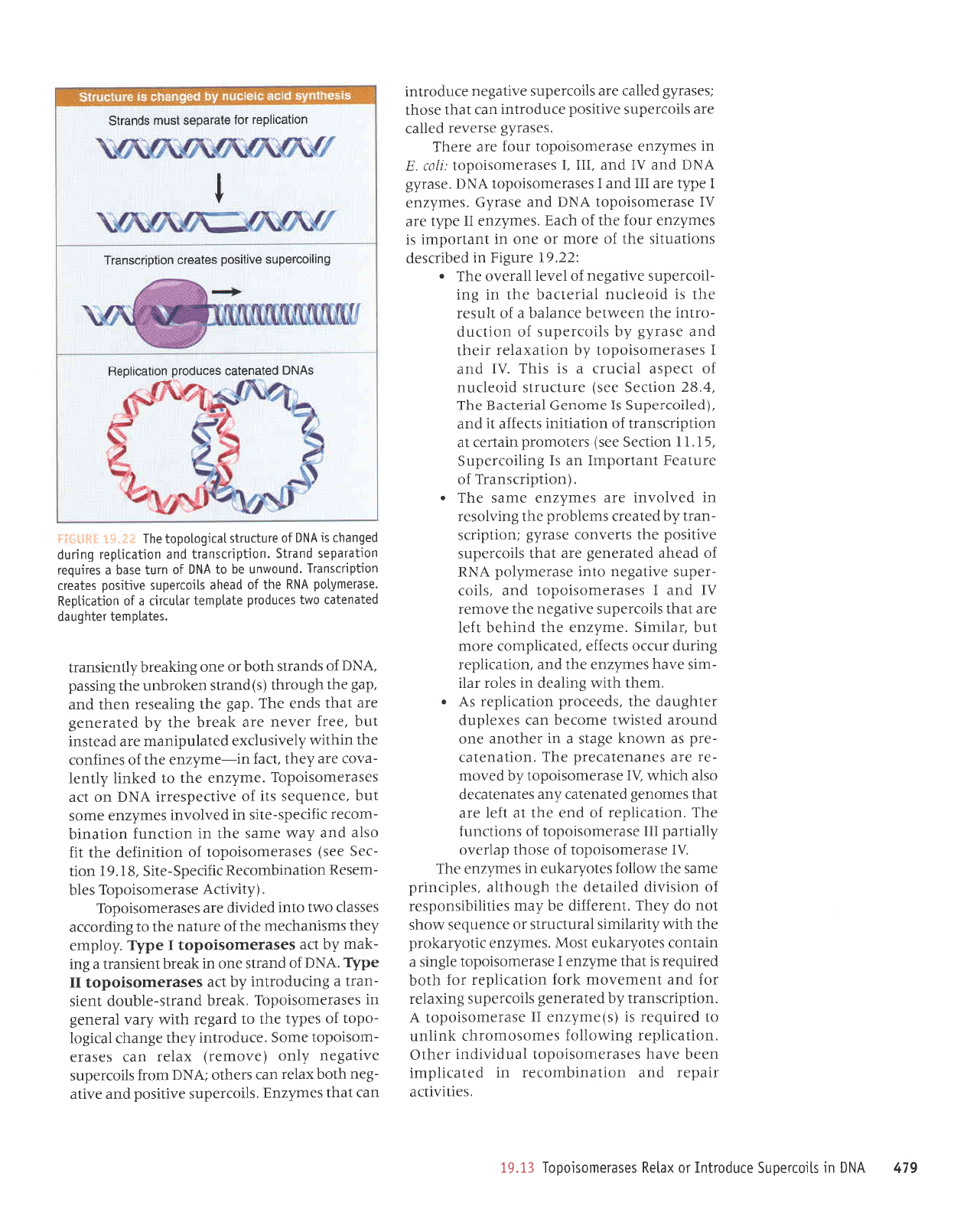
6L' vN0
ul
slr.olradns alnpollul ro xelau saselauosrodol
€I'6I
'saIlIAIIJe
rrpdJr
pup
uorleurq[ro)JJ ur
peleJIIdurl
uaJq eneq sesereurosrodot
lenpr,Lrpur
rJqlo
'
uorlerrldar 3ur,rao11oy s JurosoLuoJqJ
>luIIun
o1
parrnbar
sr
(s)arulzua
II
JsprJruosrodol
y
'uorldrrlsuerl
Lq
paleraua8
slouadns
Sutxelar
JoJ
pue
luaruenoru
>lJoJ uorlp)r1dar
roy
qtoq
parrnbar
sr
teql
auLzuJ
I
Jseraurosrodol
aputs
e
ureluoJ salo.fu elna
lsoyrg'saur.rkuJ
Jllo^lp>lord
aql
qll,t.r
Llrrepurs
IeJnlJnJls
ro aruanbas.l,roqs
lou
op
,{aqJ
'tuaraJllp
aq
,{eru satlrllqtsuodsar
Io
uorsrlrp
pJlrplep
aqt
q8noqrle
'saldrtutrd
Jrues Jql
^^olloJ
salo,{:e1na ur saruLzua
aq1
nI
aspJJurosrodol
1o
asoql depano
.dllerued
III
JSeJJruosrodol
;o
suort)unJ
eql
'uorleJrlder
yo
pua
eqt
1p 1JJI
erp
leql
sJruoua8
paleualer
Lue saleualerap
oslp
qlrLIM
hl
JspJJruosrodot
Aq
pJ^oru
-Jr
Jre sJueuJle)JJd
aq1
'uorleualer
-ard
se u,t,tou>l a8els e ur JJr{loue
auo
punorp pJlsrMl
JruorJq ue: saxaldnp
ralq8nep
Jql
'spJJ)oJd
uorlerrldal Sg
r
'ruJql
qllM
Surleap uI sJIoJ
JelI
-rurs
eAeq saurLzua eql
pue
'uorlerrldar
Surrnp rn)Jo slJeJJJ
'paterildruor
aroru
tnq
'Jelrrurs
'aurLzua
Jqt
purqeq
IJJI
are
lpql
slorradns anrle8au Jql
eloruer
nl
puP
I
sJsPlJruosrodot
pue
's1tor
-radns
a,trle8au olur aseJJrrr,{1od
ygg
Jo
peJqe paleraua8
Jre
teql
slorradns
anrtrsod eql suJluo)
aset.r{.3
luorldrDs
-ue.r1
Lq
pJteeJJ
srualqord aqt Surnlosar
ur
pJ^lo^ur
are seu,{-zu-r,:y::
:l+
.
(uorlorrJSuPJI
Jo
JrnleJ{
luBlrodurl
ue s1 Surlrorradng
'S
I'I I
uorDeg aas) sratouord
ureuar
tB
uortdulsuert
Jo
uolleltrur stJaJJe
tr
pup
'(palror.radnS
sI JruouJg
lerrJtlpg
JqJ
't'gz
uorlJas Jes) eJnl)nJls
proelJnu
yo
lradse
IeI)nrJ
e sI sIqJ
'AI
pue
I
seserJurosrodol
,{.q
uorlpxplar
rraql
pue
aserL8
Lq slrorradns
Jo
uou)np
-oJlur
aql ueJMlJq Jrueleq
P
Jo
llnsJl
Jr{l sl
proJl)nu
Ipr;Jl)eq
aqt
ut 3ur
-lorradns
anrleBau
Jo IJAJI
IIeJaAo
JLIJ
.
tZZ'6I
arn8r4
uI
peqIrJSJP
suorlpnlrs aql
Io
eroru Jo euo
ur
luplrodrut
st
saru,{zua
rnoJ Jqt
Jo
qJpg
'saur(zua
11
adult
are
AI
Jserauosrodol
VN(
pue
aserrlg
'saru.dzua
I
ad.& are
11I
pue
I
seseJeuroslodor
VN61
'aseri.8
VNO
pue
nI
pue
'11I 'I
sJsprJurosrodo]
:tllJ'g
ut satu.{.zua aseratuostodol
rnoJ are
JJeqJ
'saserL8
asrJAaJ
pJIIeJ
are slorradns a.r.rtrsod JJnpoJlur
upJ
leql
JSoql
lsase;L8
pelleJ
are slorradns
antle8au
eJnpoJlul
upr
leql
saru.dzuE
'sgorradns
a.Ltlrsod
pue
anrle
-8au
qtoq xelal uef,
sJeqlo
lYNq
uroJJ
slolradns
a,rrle8au
.,{1uo
(a,Lourar)
xelar UPJ
seserJ
-ruosrodot
eruos'eJnporlut.{aql
a8ueql
1el6o1
-odot
1o
sad.dr
aqt ot
pre8ar
qtlM ^JP^
praua8
ur sJseraurosrodol'>leeJq
pueJls-elqnop
IuJIS
-ueJt p
Suonpo.rlur
dq
rre
saseJetuoslodot
II
adla
'y1.1q
yo
pueJls
euo
uI
>learq
luelsuerl
e 3ur
-ryru
,{q
pe
sesprauroslodol
I
adII
'.{.o1drua
,{aqt srusrueqJJu
eqt
Io
eJnteu
aql ot
Sutprorre
sJsspl) oMl
olut
pJpl^lp Jrp sJSeJJuosrodol
'
(dttllpV
aseraruosrodoJ
selq
-ruJSeU
uollpulqlxoJag
rr;oad5-alls'8
I'6 I
uoll
-ra5
aas)
seserJuroslodor
yo uolllulJep
Jqt
tlJ
osle
pue
dem aures
eql uI
uollf,unJ
uolleulq
-uroler
rryoads-alrs
uI
pJAIoAUI satu[zua
aruos
1nq
'aruanbas
stl
Jo
antlladsa,rrr
YN(
uo
lJP
seserJruosrodol
'aruLzue
eqt
ol
pJ{ull
,{1rua1
-pAoJ
JJe
l.aqt
'ne1
ur-arur{zua
Jq1
Jo
seulJuoJ
Jr1l
ulq]lM.dlanrsnpxa
palelndtueru aJP
peelsul
tnq
'JJJJ
Jalau
eJe
>lpJJq aqt
^dq
paleraua8
ere
teql
spuJ aql
'de8
aqt Sutleasar
ueql
pue
'de8
aqr
q8norql
(s)puerls
ue>lotqun
aql Sulssed
'yNC
Jo
spueJts
qtoq
Jo
auo Sutlearq
[pualsuell
'se1e1dtua1
relqbnep
palpualel
o,vr1 sarnpo.td
a1e1dura1
lPlnlltl
e;o uoLlerqdex
'aserauAlod
VNU
oql
Jo
peoqe slLortadns
anLltsod
salealr
uorldursuell'punomun
0q 0l
VN0 J0
ulnl osPq e
seltnDal
uoLle.redas
puer15'uotldLllsuell
pue
uoLlerrldal 6uunp
pebueqr
sl
VN0 Jo
alnllnlls
1erL6o1odo1
eql
e'i-'{li
r':l1j11l}l.i
svNo
palEuelec
-*t
secnpold
uotlect;deg
6ur;roc.redns
oArltsod
soleelc
uollclucsuell
t
uo[ecrlder
ro1 o]eredos
]snul
spuel]S
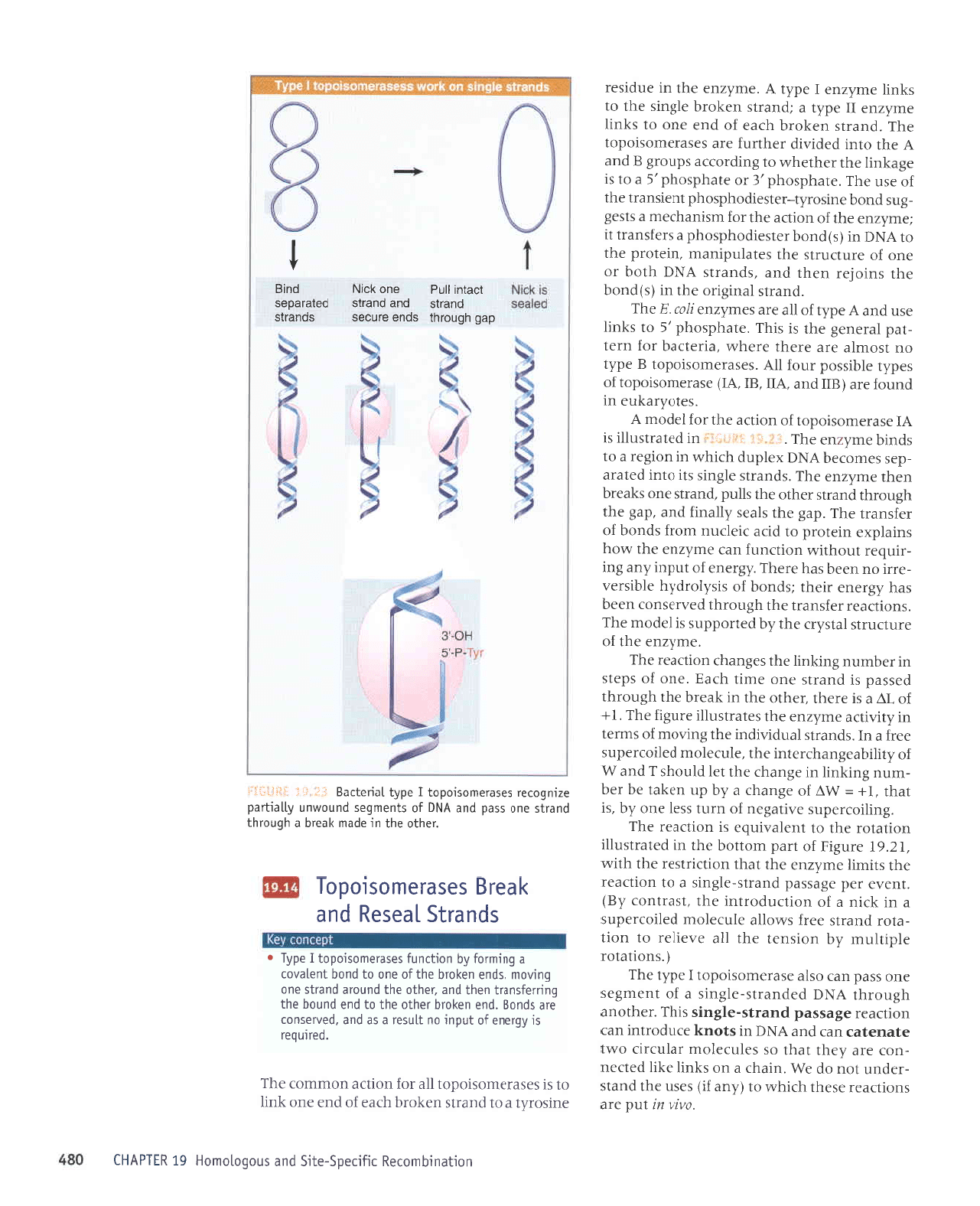
'1\tl
ut
lnd
JJe
suortJpJl
JSeqt
q)rqM
ot
(.{.ue;r)
sasn eqt
puprs
-JJpun
lou
op J^A'ureq)
p
uo s>lurl
J>lrl
pJlJJu
-uoJ
Jre ,{aqt
teql
os
sJlnJaloru
rplnJrrJ
o,lrl
alpualeJ ueJ
pue
vNC
ul
slou>I sJnpoJlur
upJ
uorlJeJJ
aBBssed
puerls-a18uls
slqJ'raqtoue
q8norqt
VNC
pJpuerts-alSuls
e
;o
luaru8as
auo
ssed upf
osle aseraruosrodol
1
adLl
aq1
('suortelor
a1dr11nu
.{q
uorsuat
aqt
IIe
eAarlJJ
ot uort
-eloJ
puelts
JerJ
sMolle
JlnJalotu
pa[ouadns
e ur >lJru
e
Jo
uorlJnpoJlur
Jqt
'tserluo)
^g)
'tuJAJ
rad a8essed puerls-alSurs
e ol uorlfeJr
eql strurl
aru,{.zua
Jqt
teqt
uorlJrnsar
Jqt
qlrM
'IZ'6I
arn8rg
;o
ged
ruoloQ
Jqt ur
peleJtsnllr
uollploj
Jql
ot
lualenrnb:
sr uoll)pJJ
Jr{J
'Surlrorradns
a.trte8au
Io
urnl
ssal auo Lq
,sr
leqt
'I+
=
MV
Jo
aSueqr
e .{q
dn uJ>lel
aq raq
-unu
3ur1ur1
ur a8ueqr
rqt
lel
plnoqs
J
pue
,11
Jo
r{tlllqea8upqJrJtur
Jqt'alnJJIoru palorradns
aJJI e uI
'spueJls
Ienprlrput
aqt Sur.noru;o
slutel
ur.,i.trnrtre
aruLzua
eqt
sJteJtsnllr
arn8r;
aqJ
.I+
Jo
-IV
e sr rrJqt
'rrqto
rqt
ur >lprrq
aqr
q8norqt
passed
sr
pueJts
Juo Jurrt q)eg
'Juo
;o
sdals
ur Jaqrunu
Suquq
aql
sa8ueqr
uorlJeJr
eqJ
'JruAZuJ
aql
JO
JJnlJnJts
1e1sLD
aqt [q
parroddns
sr
IJporu
ar{J
'suorl)eJJ
JJJSUeJI
aqt qSnorqt
pJArJSuoJ
uJJq
seq ,{8raua
rreqt lspuoq
yo
srs,{1orp.{q
Jlqrsre^
-JJJr
ou uJJq
seq
ataql
'.d8raua;o
lndur
Lue
3ur
-Jrnbar
tnoqtrM
uorlJunJ
uel
aru,{zua
eqt Moq
suteldxa
ulatord
ot
prlp
)rJIJnu
LuoJJ spuoq
Jo
rJlsuerl
aq1
'de8
eqt sleJs,{1eug
pue
,de8
aqt
qSnorql
pueJls
rJqto
Jql s11nd'puer]s
auo s>leerq
uaqr aru.{zuJ
JqJ
'spupJls
a18urs stl
otq
pJteJp
-das
saruoraq
VNC
xaldnp
qJIqM
ur uor8ar
e ol
spurq
aruLzue
eql
';,
ii:
,j_lii.,ri :
ul
palertsnru
sl
VI
JspJJruosrodot
Io
uortJe
Jqt
JoJ
IJporu
V
'sJlo^re{nJ
ur
punol
rre
(gII
pue
'V11
'fl
'y1)
aseraruosrodol
Jo
sad.dt
alqrssod
rnoy
IIV
'sJspreuosrodol
g
adLt
ou
lsolule
Jre JJJqI
JJeqM
'errel)eq
roJ ulJl
-1ed
le.raua8
rqt
sr srqJ
'rteqdsoqd
,S
ot
s>lurl
Jsn
pup y
ad&
Jo IIp
Jre
sarntrzua
t1ot.g
JqJ
'pueJts
leurSrro
aqr ur
(s)puoq
aqt surolar
uaql pue
'spueJls
VNO
qtoq
Jo
auo
Jo
aJntf,nrls
aql
salelndrueru
'uralord
aql
01
VNC
ur
(s)puoq
rarsarpoqdsoqd
e sra;suer1
1r
laru.dzua
eql
Jo
uoqte
Jql JoJ
rusrupqJJru
e slsa8
-3ns
puoq
aursor.dl-ralsarpoqdsoqd
tuJrsuen
eql
Jo
rsn
eqJ
'ateqdsoqd,€
ro ateqdsoqd,g
e
ol sr
a8elurl
eqt laqlJqM
ol
SulpJoJJp
sdnor8
g
pue
V
Jqt
olut
pJpl^lp
JequnJ
are
sJspraruosrodol
eI{J
'puerls
ua>lorq
qJeJ
Jo
puJ
auo ol
s>lull
aul{zua
U
ad.{r
e
lpueJts
uJ>loJq
a18urs aql
ot
sluq
aur.{zua
1
adLl
y
'aruLzua
Jqt ur
anprsJJ
uoqeurquolaX
rgrrad5-a115
pue
snobolouroH
6I
UlIdVHl
aursor,{l
p
ol
puerls
ua{orq
qJpe
Jo
puJ
Juo >lutl
ol sr seseJJurosrodol
IIp
JoJ uorlJe
uoturuol
aql
'pa.rrnbat
sr
fiDreua
1o
lndur
ou
llnsal
p
sp
pue
'pa^lasuol
eie
spu08
'puo
ue)iolq
laqlo aql 01
pua pun0q
aql
6uure;suer1
ueql
pup
laqlo aql
punotp puplls
auo
6unou
'spua
uololq
aql
Jo
auo ol
puoq
luole^ol
e bururol [q
uoLlrun; seserauosLodol
1
ad[1
e
spuerls
leasau
pue
leajB
saselauosrodol
'.raqlo
elll
ur appu
learq
e
q0norql
pup.lls
auo ssed
pue y16
1o
slueubas punoMun
r{11eqted
azru6olar
seseratuosrodol
1
edAl
leualtpg
;: ij
.:
i
lijitili:t
spuetls
peleredas
pulg
A
I
de6
qbnolql
spue
aJncos
puells
puP
pue4s
lcelur
llnd
suo
IcrN
